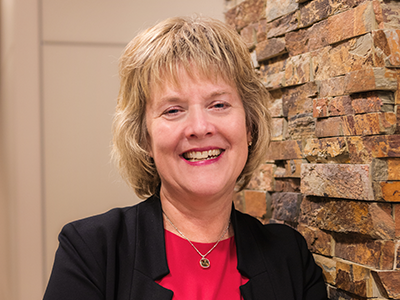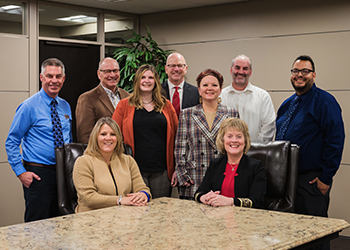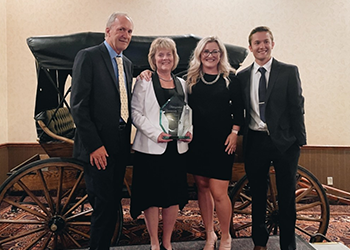
Confidence, loyalty and hard work pay dividends for leader of North Dakota bank
Editor’s note: Our thanks go out to Bell Bank, which sponsors the Banker of the Year program.
The 340 employees of First Western Bank & Trust likely will not use the term “acquisition” to describe how their bank leapt from roughly $1.1 billion at the beginning of 2020 to $1.85 billion by year’s end once it had absorbed Fargo, N.D.-based BlackRidgeBANK. The preferred term — according to Brenda K. Foster, leader of Minot, N.D.-based First Western Bank & Trust — is “merger.”
The words “merger” and “acquisition” are typically linked in banking, often swapped without thought to their meaning. But the words connote differently, both in action and emotion. Consider the relational impact of using they/them/theirs versus we/us/ours. Which terms divide? Which ones include?
Foster has given a great deal of thought to what it means to choose words carefully. Speaking with intention is a defining characteristic, say those who know and work with her.
And so in 2019, when Foster was two years into the top job at a bank that has been the setting for her 40-year career, Foster led the bank through its first-ever merger, which quadrupled its branch network, grew its presence in Bismarck, opened the bank to growth markets in eastern North Dakota along with the Brainerd Lakes region of Minnesota, and positioned it to plant its flag in 2021 in burgeoning Sioux Falls, S.D.
Throughout that process, Foster — who’s only ever worked at this one bank — has continued to mentor and support her workforce. She’s also delivered on her board’s strategic desire to diversify its portfolio, and has doubled down on her service to the industry in North Dakota, and beyond.
Brenda K. Foster is BankBeat’s 2022 “Banker of the Year.”
Speaking about growth
It takes humility to look at another bank’s processes and products and deem some of them superior to your own. At BlackRidgeBANK, “there were things they did well and she knew it,” said Dawn Ystaas, First Western’s chief financial officer. Foster was “very open-minded about what BlackRidge offered,” Ystaas said.
Foster’s inclusivity of the acquired institution hasn’t been common in her experience, said Ystaas, a former bank examiner who had been chief risk officer at Dickinson, N.D.-based American Bank Center (now Bravera Bank) before joining First Western. Ystaas had the M&A experience Foster lacked, and was impressed by her boss’s approach. “She didn’t just come in and say, ‘this is the way it’s going to be.’ She looked at the core systems, assessed everything — products, services, processes — to decide what to keep, what was best for the organization and its customers,” Ystaas said.

When the BlackRidge opportunity first emerged, Foster said that the bank’s footprint fit well with First Western’s. “We had the same cultural goals and similar values. We didn’t know where this would go because we had never made an acquisition or a merger before.”
It was a large deal, at 10 branches and nearly $500 million in assets. “It took us several months of going back and forth and having conversations and really vetting the institution, as well as the employees, and then figuring out that this was a direction we wanted to go.”
Foster understands to her core that it is the employees (on both sides of a deal) who help a combined institution succeed. This is where Foster’s inclusive style of leadership closed whatever gaps her inexperience with M&A may have presented.
“She’s accessible to everybody, from custodian to CFO,” Ystaas said. “She’ll take calls, get back to people. She’s involved in lots of volunteerism, sitting on boards; she practices what she preaches.”
Throughout the “merging” process, Foster engaged with the employees of the new branches, reached out and remained helpful, Ystaas added.
Foster is “authentic,” said Nic Rahrich, Twin Cities market president and chief culture officer for First Western. “She has a demonstrated passion for the role. It’s like a calling.”
Rahrich worked at U.S. Bank in Bismarck before relocating to the Twin Cities and finding a home at First Western’s Eden Prairie, Minn., office. Rahrich underscored Foster’s insistence on using the term “merger” in any discussion about BlackRidge. “The talent we had from the other bank and the customer base meshed well with our group,” Rahrich said.
Though there were challenges, as there typically are, Foster remained resolute. “She doesn’t get hung up on change. She adapts and wants to help others do the same. As we grow, we look for ways to innovate,” Rahrich said.
Hometown bank; homegrown banker
Sustaining growth, whether it comes organically or through merger, is hard work. Net interest margins are thin; credit risks are expanding. Foster, having not only grown with the bank but having “grown up in the bank,” is decidedly the leader for the time.
“She understands hard work because she’s done it and continues to do it,” Rahrich said. She’s done it all, that is.
First Western Bank & Trust was founded in Minot by the late Jack Hoeven the same year Foster was born: 1964. Hoeven is the father of U.S. Sen. John Hoeven (R-N.D.).
Jack Hoeven spent his life in banking and was known for his commitment to Minot, a town of nearly 50,000 people (when counting the population of nearby Minot Air Force Base), situated on the eastern edge of the Bakken Oil Shale Basin.
Foster was 17 and still in high school when she started at the bank. “My first job here was filing checks manually. Really, I was the errand girl,” said Foster, the oldest of three daughters raised by parents who focused their lessons on working hard and doing your best, getting along, being honest, and treating people with respect. “Both my parents taught us to remain humble.”
Foster earned an associate’s degree in 1984 by focusing on general legal studies, but opted to accept a full-time job at the bank instead of working in a law firm. She started in customer service, worked in proof, in safe deposit, opened CDs, migrated to the trust department, typed up loan documents (on a typewriter!), and earned the notable distinction of working on the bank’s first computer (a RadioShack TRS-80).
By the end of the 1980s, Foster was married and contemplating career advancement and/or having children. The future Sen. Hoeven, who was in charge of the bank’s trust department, encouraged Foster to look more broadly at what banking could provide. The path he suggested compelled Foster to enroll at Minot State University, where she earned a bachelor’s degree in accounting with a banking and finance concentration in 1992.
Foster credits the bank and her managers for ensuring she had room to be the mom she wanted to be to daughter, Danielle (27), and son, Dustin (24). “I obviously have never been a job hopper,” she laughed. “When I make a commitment, I follow through.”
Foster also has the unique distinction of helping John Hoeven polish his resume as he applied to become president of the Bank of North Dakota, which preceded his term as North Dakota’s Governor.
Today, First Western has nearly 44 percent of its loans in commercial real estate across its now three-state footprint. One-fifth of its portfolio is in commercial and industrial loans. Its leasing operation, which is national, comprises 11 percent, or $147.5 million, of the portfolio. Residential real estate accounts for 14 percent of the pie, with ag (nearly 7 percent) and consumer lending (nearly 4 percent) the last two slices in the pan.

Much of the bank’s growth has come through insurance. The bank earns $4.8 million in commission income on its insurance business. Since establishing First Western Insurance in 1999, the bank has acquired four insurance agencies; today, its insurance operation is one of the largest agencies in North Dakota, and it is licensed to operate in 17 states. Foster credits insurance (and trust) for those deep, rich relationships that keep customers from wandering over to its competitors. “It works well for everybody,” Foster said.
First Western’s Eden Prairie bank houses its 30-person leasing division, described as focused on “small ticket,” short-term (12 to 16 month), five-figure deals. First Western entered the Twin Cities through its acquisition of this leasing operation in 2000. It opened a loan production office there in 2002, and the LPO was converted to a full-service branch in 2006. It’s one example of the bank’s approach to organic growth that carried it over the $1 billion mark prior to the BlackRidge deal.
Committed to a stronger industry
“Brenda Foster is someone who I’ve watched make a real positive influence,” said Rick Clayburgh, president and CEO of the North Dakota Bankers Association.
Though First Western Bank & Trust is more active in the Independent Community Banks of North Dakota than in NDBA, and Foster served ICBND as its 2012-13 chair, the banking community in North Dakota is small and collegial. First Western belongs to both associations.
“Brenda empowers her employees to be active where it makes sense for them,” Clayburgh said. “She empowers them to excel at what they do.”
Barry Haugen, president of the ICBND, calls Foster “a voice of reason.” She also makes herself available, much like she does at the bank, for the betterment of the industry. Foster impressed Haugen by the way she considers all angles of a problem. She “takes many perspectives to heart; she’s always very prepared and professional; she is a subject matter expert on many things because she’s done everything,” he said.
On the national stage, Foster has also made an imprint. Foster has served on the Independent Community Bankers of America’s Large Bank Council, whose participants inform the community bank-focused advocate on issues of concern to its largest members — a cohort that’s quickly growing thanks to M&A. Top issues these days include the ESG (Environmental, Social & Governance) movement, climate disclosures and, of course, vaccine mandates.
Foster served as chair of the Large Bank Council in 2018 and 2019; both as a member and as chair, she remained steadfastly focused on the community banking model, said ICBA’s Ron Haynie, SVP of housing and finance policy, who served as the Council’s liaison during Foster’s tenure.
It may have been a matter of timing for her, this focus on retaining a distinctly “community bank” ethos. In the same stretch of months, First Western was preparing to make a leap in asset size to the tune of $500 million. “Anything that took away their ability to be a relationship banker as they got larger was very concerning to her,” Haynie said.
Once Foster cycled off the Large Bank Council, she rolled right on over to the ICBA’s education committee — education being important to her core. (She is chair of the board of regents at Minot State University.) Here also, Foster’s characteristic inclusiveness shone through.
“She’s always so intentional and mindful about the words that she shares with you,” said ICBA’s Lindsay LaNore, EVP and chief learning and experience officer.
When Foster speaks, “your ears perk up; you want to listen to what she has got to say, and it earns her respect from her committee peers, and the industry,” LaNore said. “The community bankers in North Dakota, they all are friends. They support each other; they cheer each other on; and you can see that.”
Clayburgh concurred about the players in his state, noting the camaraderie between them. “Brenda fits right into that,” he said, noting that Foster’s 2021 appointment to the State Banking Board was just one reason among many that she was deserving of recognition. “To have someone who understands the inside workings of an institution is incredibly important,” Clayburgh said. “She understands a bank structure top to bottom.”
 It was Lise Kruse, commissioner of the North Dakota Department of Financial Institutions since 2017, who asked Foster to join the State Banking Board, and who recommended Foster to Gov. Doug Burgum. “When we look at our board, we want diversity in the geography and the size of our banks,” Kruse explained. They also look for bankers who are actively engaged in promoting the industry. “She is the portrait of a community banker. She is very smart. She cares about people. She’s always very articulate.”
It was Lise Kruse, commissioner of the North Dakota Department of Financial Institutions since 2017, who asked Foster to join the State Banking Board, and who recommended Foster to Gov. Doug Burgum. “When we look at our board, we want diversity in the geography and the size of our banks,” Kruse explained. They also look for bankers who are actively engaged in promoting the industry. “She is the portrait of a community banker. She is very smart. She cares about people. She’s always very articulate.”
Foster also serves as a Class A Director of the Federal Reserve Bank of Minneapolis.
One might wonder how a person manages all those commitments and a $1.93 billion bank. Foster said she rarely leaves the bank before 7 p.m. “I like to come in on Sunday when it’s quiet and I can really think about other things and get into some deeper projects. So I’ll come in for a few hours during football.”
Learning along the way
Along the path to the top job at First Western, Foster served as executive secretary to Jack and John Hoeven. That’s when she met chief lender Rich Campbell, her immediate predecessor for the role of president and CEO. Their desks were adjacent. Foster helped Campbell type loan documents when she had time. Jack and John Hoeven would look to Foster to prepare their loan docs. Occasionally, Foster would do a loan closing. As years passed, Foster took loan customers under her own name.
“She was passionate about the loan customer,” Campbell recalled. And when she had questions on how to structure a loan, she’d turn to Campbell for guidance, he said.
This type of on-the-job learning fit Jack Hoeven’s management style. In a 1999 interview with BankBeat, when John Hoeven was president of the Bank of North Dakota and earned recognition as a “Rising Star in Banking,” he said of his elder:
“My father wasn’t what you’d call tutorial … He generally made an evaluation whether you were ready to do something, and then sent you out to do it. When he decided I’d had enough background in banking, he decided I could make loans. That was it. If you were exposed to how things worked, you should have figured it out by now.”
Foster figured out how things worked too. Though she never really considered herself as a candidate to lead the bank. That seed was planted by Campbell, who Foster called her No. 1 mentor.
“Jack had a different style,” Campbell said. “He was stern. But he also had a strong passion for taking care of the customers. She felt the same way.”
Recalling a difficult loan workout situation, Foster said she needed to fight the impulse to go pick up the collateral before something happened to it. Better, she said, was to take the time to analyze and think over the best approach for the customer. “Really, the best approach was talking through what their situation was and being able to come to a common decision that would help both the bank and the customer.”
Foster is the opposite of stern, Rahrich said. “Brenda is by far the most unique leader I’ve ever worked for,” Rahrich said. “It’s different working at a female-led bank. I’m here because there’s nuanced differences, almost indescribable.”
Ystaas also likes the way Foster manages. “A female CEO is pretty rare,” Ystaas said. “For me, she’s easy to relate to. She has a lot going on but still has time to stay in the loop. She is a boots-on-the-ground kind of manager. Responsive.”
In his later years, Jack Hoeven and Foster became close friends. In 2017, as the board considered her to become its next president and CEO, Hoeven blessed the decision, which she said meant a great deal to her. (Hoeven died later that year.)
These days, Foster carries the stories of Jack Hoeven to her employees to keep his legacy alive. It’s important, she said, that people who will never have the opportunity to meet the bank’s founder can understand that he wanted the bank to be a good community partner and the bankers to be passionate about, and care for, its customers.
A central focus for Foster, beyond providing the best possible customer experience, is continuing to diversify the bank’s already varied portfolio, and its view beyond the immediate horizon. Her legacy remains inextricably linked to the bank. “I just want to be remembered as a good mentor,” she said. “Part of the team.”
Her parents’ lessons in humility took root.
“The bank has grown much quicker that I would have expected,” Campbell said. “She did that.”
The focus on sustainable growth has Foster committed to looking at any opportunity that presents. The bank opened an LPO in Sioux Falls in 2021, and recently received approval to open a branch; the initiative is led by two seasoned bankers who, like Rahrich, came to First Western from U.S. Bank.
It’s an important expansion, and not the bank’s last. “I would say [our footprint is] not complete,” Foster said. “If the right opportunity comes up, we’ll continue to take a look and see if it makes sense for us. So there’s nothing on the table today, but that doesn’t mean there won’t be tomorrow.”
Mark her words.

